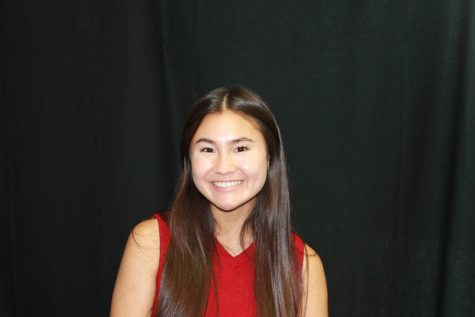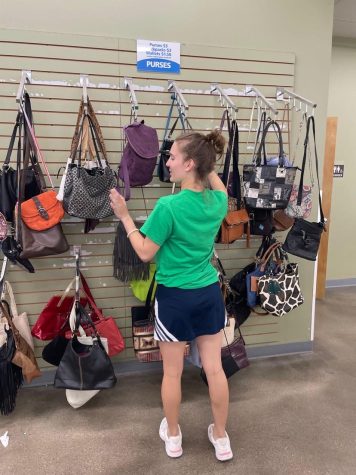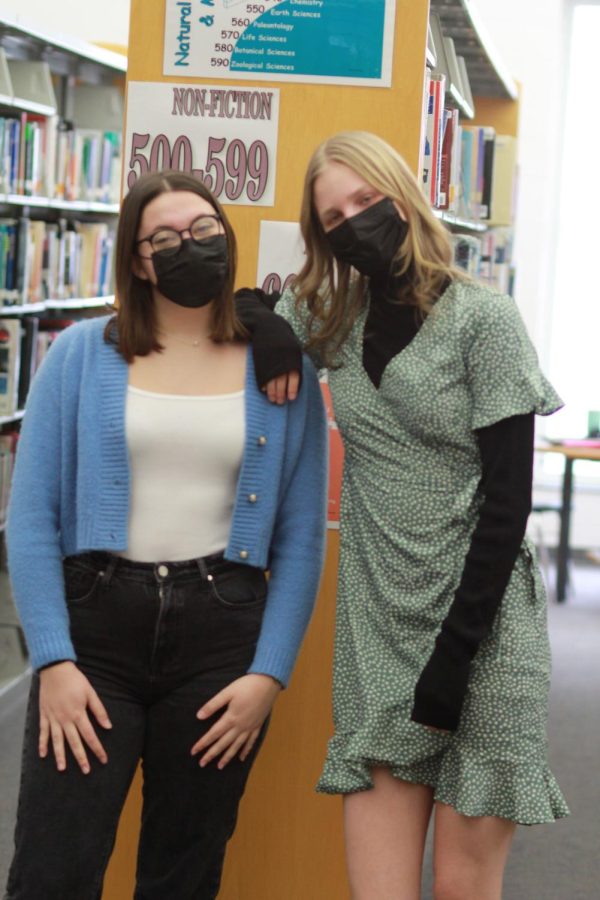Exchange students compare fashion trends from their home countries
Kemppainen and Falaschini stand with each other in the library.
Fashion is an art form that people from all around the world choose to embrace.
After speaking with exchange students Olimpia Falaschini and Kaisa Kemppainen, we were able to compare the wide variety of trends found throughout the United States, Finland and Italy.
For seniors Olimpia Falaschini and Kaisa Kemppainen, everything at Grand Haven High School is a new experience, and to these stylish ladies, the fashion in particular is a whole new ball game.
Coming all the way from Finland, senior Kaisa Kemppainen was able to sit down with us to discuss the disparity between trends in the United States and her home country.
“The fashion in Finland is very similar to America,” Kemppainen said. “We have very similar trends. Skinny jeans are not in anymore and people dress casually with straight leg pants”
While there are many parallels between fashion in the US and Finland, they have their own funky shops that are native to them.
Marimekko is a Finnish design company that Kemppainen highlighted. They are known for their clothing, accessories and home decor.
“It’s becoming more popular in Finland. It hasn’t made it to the U.S. very much yet, so that’s really cool, ” Kemppainen said.

Aside from the day to day trends that Kemppainen spotted, she also took note of the disparities between Grand Haven and her home turf.
“There is a wider variety here though, people either dress up or down, whereas in Finland it’s usually casual,” Kemppainen said.
Contrary to Kemppainen, Olimpia Falaschini from Italy faced a huge culture shock coming to America.
According to Falaschini, everyday attire back at home is much more professional than what is found in the United States.
Aside from the day to day trends that Kemppainen spotted, she also took note of the disparities between Grand Haven and her home turf.
“There is a wider variety here though, people either dress up or down, whereas in Finland it’s usually casual,” Kemppainen said.
Contrary to Kemppainen, Olimpia Falaschini from Italy faced a huge culture shock coming to America.
“When I saw people in their pajamas [at school] I suddenly felt overdressed,” Falaschini said. “At home we have strict dress codes and typically dress formally for school. If I wore sweatpants or even leggings in Italy, people would give weird looks, but here it is very normalized and that took me a long time to get used to.”

In Italy, the rigidity of weekdays leaves the opportunity to dress up on the weekends, something Americans don’t typically indulge in.
“It’s something we enjoy doing together,” Falaschini said. “I remember having my best friend come over and we would get ready for the night together and dress up to go out”
Popular stores such as Zara, Nike and Adidas remain staples worldwide, but both Falaschini and Kemppainen enjoy online shopping at these places rather than in person.
“I like shopping online because it’s easy and I can always find clothing that fits just right.” Kemppanien said. “I’m tall, so being able to shop online and find that perfect fitting pair of pants is important to me.”
In America, thrift stores are all the rage, but for Falaschini and Kemppanien, thrifting is a different story.
“We don’t have thrift stores where I’m from in Italy,” Falaschini said. “I think they’re interesting, but in Italy it would probably be looked down on and I don’t think a lot of people would go there even if we had second hand stores”
However, for Kemppainen, thrifting isn’t all new.
“I like to thrift, but I have to say the thrift stores in Finland aren’t as good as they are in America” Kemppanien said. “The options are a lot of drama clothes for plays but not really for everyday school attire. I don’t have a lot of thrift stores in my area”
After being in the U.S. for a few months already, the girls are eager to expand their fashion taste. Whilst being in the states the girls will be able to learn things to take back home with them while simultaneously sharing a piece of their cultures with us.
“I’ve loved not only getting to know the people here but getting to see all the fashion differences from home and America,” Falaschini said. “I’ll definitely be taking some trends home with me to Italy.”

Senior Elena Yu is looking forward to joining the Bucs’ Blade team for the first time, despite it being her last year in high school. She hopes to participate...




